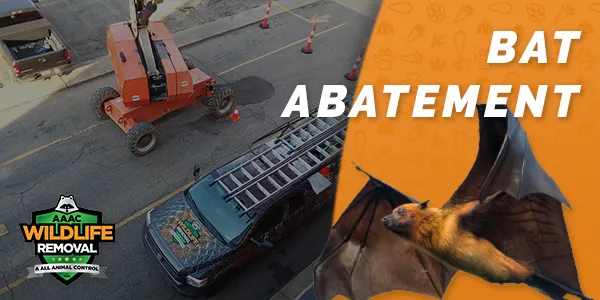Bats are very important to our ecosystem. Bats do many things for us: they pollinate plants, control pests, and consume their weight in harmful insects every night. However, they can also be a nuisance, especially when they are roosting in human-inhabited areas. Their populations have been steadily declining due to habitat destruction and the white-nose syndrome, which is why they are protected by law, and killing or extermination is considered illegal.
Abatement and remediation
Bat abatement refers to getting rid of bats from any structures they roost in – this may involve bat trapping and removal (federal law prohibits killing them), exclusion, or other methods that don’t harm the animals. Bats roosting in human-inhabited buildings can be a nuisance and bat infestation remediation is often necessary. If you live in an area with a decent bat population, and you can hear noises in your attic then you may be in the market for bat control services.
Bats are protected by law
Most bat species are federally protected under the Endangered Species Act of 1973. This means that killing them is illegal without permission from federal authorities who may grant it if there are no other options. Bat removal is not legal at all unless they present an imminent danger to human health or safety – like when living inside a home where people reside full time.

Bat control methods
There are three main types of bat control: lethal removal (generally illegal), non-lethal control (such as bat traps or bat deterrents that use sound waves instead of chemicals that can harm humans), and exclusion (keeping them out).
Lethal Removal
A lethal removal is rarely an option because it is inhumane and it’s illegal at a federal level to kill bats. There are also more effective yet humane solutions to get rid of bats from buildings. Bat extermination also creates the problem of dealing with the bat carcasses once they’re dead.
Non-lethal control
Non-lethal options include deterrents: devices that push bats away with a high-frequency sound waves to drive them out. Or, baiting and live trapping so that the bats can be removed humanely. These methods are much more popular because they do not harm the bats and are tend to be more effective than other other home remedies.
Repellents like mothballs or ammonia are used by some people, but they are quite impractical as you’d need a lot of them to work as well as the fact that the smell dissipates rather quickly – Not to mention the smell will work its way to your living areas and cause respiratory problems for people.
Bat exclusion
Exclusion is by far the best option to get rid of bats and any wildlife pest control company will offer exclusion services. Exclusion should always be the primary option when bat control is needed because it’s both humane and effective at keeping bats out of buildings. It is usually done by sealing all entrances, including ones that are smaller than one inch wide. This ensures that no bat can get inside your building after you’ve excluded them. Pest control professionals will do everything from installing bat gates, replacing rotted wood on windowsills, caulking cracks underneath doors, or anything else necessary to prevent re-entry. This is the most humane way of doing removal because it doesn’t harm the bats or cause other problems later on.

Remember to consider: Bat maternity season
When excluding bats it is important to plan it so it doesn’t coincide with bat maternity season (May 15-Aug 15). Doing exclusion during this time is inhumane and illegal because flightless baby bats will be in the colony and excluding the mothers from the roost will cause them to starve and die.
Bat exclusion process
- Identify a possible entry and exit points
- Seal all identified openings except one
- Install a one way door on the last opening
- Check to be sure that all bats have been excluded
- Decontaminate and restore the attic
- Fix damage to the interior(including replacement of insulation if necessary) and exterior
The first step is usually is to spend a great deal of time locating entry and exit points. This is done by looking for holes, crevices, and gaps on the exterior of a building. You will also need to identify any gaps in foundation walls that may allow bats access as well as other possible openings like chimneys, vents, roof spaces, and so forth.
Once all potential entrances have been identified you can start sealing them off one at a time leaving one with an exclusion device or one-way door. These work because they only allow bats out but not back into your home once installed properly.
After excluding all the bats from your property it’s necessary to do an attic cleanup before doing repairs inside and outside the structure. The process usually involves getting rid of feces, and any loose insulation before doing repairs. The addition of a bat house can also help bat control efforts by giving them a place to live outside of buildings.
Dangers and problems caused by bats
Bats can cause all kinds of problems for you, including:
- spreading diseases like rabies and histoplasmosis
- making noises in the attic
- causing structural damage
- destroying your attic with bat guano
- transmitting parasites like mites and bugs
Diseases
These critters often carry bat diseases that humans can catch. These include things like rabies, that can be transmitted to humans or pets, and Histoplasmosis, a severe lung disease caused by Histoplasma capsulatum. Guano is the greatest risk you face when you have bats inside your home and removal is often done to avoid this health risk.
The bat’s natural habits of living in bat colonies can cause an issue with the concentration of bat droppings, which is toxic if it accumulates around vents or other parts of a building where people might be breathing this air. Droppings buildup also attract cockroaches and mites as well as create another nesting area for pests like ants.
Structural damage
Bats can also cause problems with a home’s structure if left unchecked, such as weakening walls or ceilings, and may cause them to collapse. In addition, they will start making bigger holes once they find an entry point which means removal should happen before these damages become too significant.

Noise
The noise of bat colonies roosting can disrupt sleep patterns for the people who live there. When the problem gets handled early on (before there are too many bats) then you probably never hear them. However, the noise does get worse when you ignore them though because eventually one family can turn into several hundred bats hanging out in your attic!
Parasites like mites and bat bugs
Bats can carry mites and bugs that will make their way to your living areas if removal isn’t performed. These parasites can cause serious allergies and health risks for humans and pets!
What attracts bat into buildings?
Bats are attracted to buildings because they provide a safe roosting place away from predators and the elements. Buildings with bat-friendly features like large openings, crevices, or areas where there is little disturbance make good bat refuge. Additionally, female bats will roost to have their pups and nurture them there until they are old enough to fly.
Factors in bat removal
The factors that are taken into account when removing bats from an area include:
- how many bats you have
- where the bats are roosting (inside or outside)
- whether you want them gone permanently or just temporarily.
Size of infestation & no. of bat entry points
The colony size and the number of entry points all affect what your removal costs will be. Larger colonies and more entry points will typically cost you more. A small infestation with a few bats should cost much less, while bats in a large building could make for an expensive removal.
Location and accessibility of the Bat Infestation
The location of the colony can affect your exclusion costs. For example, colonies located in basements and stairwells will be less expensive than bats living high up on the walls or roofs or inside of a chimney.
Clean up and damage repair
Another factor that affects bat removal costs is whether guano needs to be cleaned up after the bats are gone. For example, dropping cleanup can increase cost by thousands. Additionally the repair on the interior and exterior of your building can add an even greater expense.
FAQs
Does homeowners insurance cover bat removal?
Homeowner’s coverage generally does not reimburse for bat removal. Most companies consider this a maintenance problem. Bats can get through holes the size of a dime to get into your home.
How long will bat remediation take?
Remediation usually takes two to four days – It depends on how many bats are inside and whether they’re hibernating or not. During cold months remediation might be impossible or take far longer than usual.
What kind of bat do I have?
The most common bats in homes are the big brown bats and little brown bats. These species prefer to roost in bat houses, attics, and chimneys. It is very likely that one of these two is in your home. However, there are also other bats that like to roost inside homes such as the Mexican free-tailed bat. Call us so we can help you determine which bat is in your home and assist you in removing them.
What is bat guano?
Bat guano, also called bat feces or bat poop, is composed of the urine and waste material excreted by bats as they roost inside a building. It accumulates on surfaces below where the bats reside such as ceilings and walls before it falls to the ground beneath them. Guano can contain harmful parasites and the fungus that causes histoplasmosis. They should not be touched with bare hands and must only be removed using protective gear like gloves, masks, goggles, etc…
Are Bats Dangerous?
Bats normally aren’t dangerous but they can be. The main danger with bats is the guano build-up that comes with a bat infestation.
Originally published on https://aaacwildliferemoval.com/blog/bats/bat-abatement




